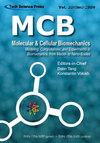基于IVUS和OCT随访图像的患者特异性流体-结构相互作用模型预测斑块进展
Q4 Biochemistry, Genetics and Molecular Biology
引用次数: 1
摘要
动脉粥样硬化斑块的进展通常被认为与形态学和力学因素密切相关。血管内超声(IVUS)和光学相干断层扫描(OCT)图像的斑块形态信息可以相互补充,提供更准确的斑块形态。结合IVUS和OCT建立流固耦合(FSI)模型,获得准确的斑块应力/应变和流动剪切应力数据进行分析。准确和完整的成像和先进的建模导致准确的斑块进展预测。在征得患者同意的情况下,获得1例患者左旋冠状动脉和右冠状动脉在基线和随访时的体内IVUS和OCT冠状动脉斑块数据。由专家对基线和随访IVUS和OCT图像进行共同配准和分割。基于合并的IVUS和OCT数据构建了基线和随访的循环弯曲3D FSI模型,以获得斑块应力/应变和血流剪切应力数据,用于预测斑块进展。每张切片选取平均帽厚、脂质面积、钙化面积、管腔面积、斑块面积、斑块负荷、斑块壁剪切应力(WSS)、斑块壁应力(PWS)和斑块壁应变(PWSn) 9个因素(6个形态学因素和3个力学因素)。选择斑块面积增加(PAI)和斑块负担增加(PBI)来衡量斑块进展并作为预测的目标变量。将9个因子的所有可能组合馈入广义线性混合模型,对PAI和PBI进行预测,并量化其预测精度。本文将预测准确度定义为敏感性和特异性之和。结合9个因素优化后的预测因子对PAI的预测精度为1.7087(灵敏度为0.8679;特异性:0.8408)。PWSn是PAI的最佳单因素预测因子,准确率为1.5918(灵敏度为0.7143;特异性0.8776)。结合平均帽厚、钙化面积、斑块面积、PWS和PWSn预测PBI最佳,准确率为1.8698(灵敏度0.8892;特异性:0.9806)。PWSn也是PBI的最佳单因素预测因子,准确率为1.8461(灵敏度为0.8784;特异性0.9677)。虽然WSS被普遍认为是斑块进展的重要因素,但在任何指标上,其预测斑块进展的能力都相对较差(PAI的准确性、敏感性、特异性分别为1.0607、0.0893、0.9714;PBI: 1.5431 / 0.6811/0.9032)。与使用单一因素预测相比,结合形态学和力学危险因素可能导致更准确的进展预测。PWSn在单因素斑块进展方面优于WSS。IVUS+OCT为形态学和力学因素的准确数据奠定了基础。致谢:本研究得到NIH拨款R01 EB004759和江苏省科技厅拨款BE2016785的部分支持。本文章由计算机程序翻译,如有差异,请以英文原文为准。
Predicting Plaque Progression Using Patient-Specific Fluid-Structure-Interaction Models Based on IVUS and OCT Images with Follow-Up
Atherosclerotic plaque progression is generally considered to be closely associated with morphological and mechanical factors. Plaque morphological information on intravascular ultrasound (IVUS) and optical coherence tomography (OCT) images could complement each other and provide for more accurate plaque morphology. Fluid-structure interaction (FSI) models combining IVUS and OCT were constructed to obtain accurate plaque stress/strain and flow shear stress data for analysis. Accuracy and completeness of imaging and advanced modeling lead to accurate plaque progression predictions.
In vivo IVUS and OCT coronary plaque data at baseline and follow-up were acquired from left circumflex coronary and right coronary artery of one patient with patient’s consent obtained. Co-registration and segmentation of baseline and follow-up IVUS and OCT images were performed by experts. Baseline and follow-up 3D FSI models with cyclic bending based on merged IVUS and OCT data were constructed to obtain plaque stress/strain and flow shear stress data for plaque progression prediction. Nine factors (6 morphological factors and 3 mechanical factors) including average cap thickness, lipid area, calcification area, lumen area, plaque area, plaque burden, wall shear stress (WSS), plaque wall stress (PWS) and plaque wall strain (PWSn) were selected for each slice. Plaque area increase (PAI) and plaque burden increase (PBI) were chosen to measure plaque progression and serve as the target variables for prediction. All possible combinations of nine factors were fed to a generalized linear mixed model for PAI and PBI prediction and quantification of their prediction accuracies.
In this paper, prediction accuracy was defined as the sum of sensitivity and specificity. The optimized predictor combining 9 factors gave the best prediction for PAI with accuracy=1.7087 (sensitivity: 0.8679; specificity: 0.8408). PWSn was the best single-factor predictor for PAI with accuracy=1.5918 (sensitivity: 0.7143; specificity 0.8776). A combination of average cap thickness, calcification area, plaque area, PWS and PWSn gave the best prediction for PBI with accuracy=1.8698 (sensitivity: 0.8892; specificity: 0.9806). PWSn was also the best single-factor predictor for PBI with accuracy=1.8461 (sensitivity: 0.8784; specificity 0.9677). Although WSS was commonly accepted as an important factor for plaque progression, it showed relatively poor ability for prediction of plaque progression in any measure (accuracy, sensitivity, specificity of PAI: 1.0607, 0.0893, 0.9714; PBI: 1.5431/0.6811/0.9032).
Combining morphological and mechanical risk factors may lead to more accurate progression prediction, compared to the predictions using single factor. PWSn is better than WSS for plaque progression using single factor. IVUS+OCT formed basis for accurate data for morphological and mechanical factors.
Acknowledgement: This research was supported in part by NIH grant R01 EB004759, and a Jiangsu Province Science and Technology Agency grant BE2016785.
求助全文
通过发布文献求助,成功后即可免费获取论文全文。
去求助
来源期刊

Molecular & Cellular Biomechanics
CELL BIOLOGYENGINEERING, BIOMEDICAL&-ENGINEERING, BIOMEDICAL
CiteScore
1.70
自引率
0.00%
发文量
21
期刊介绍:
The field of biomechanics concerns with motion, deformation, and forces in biological systems. With the explosive progress in molecular biology, genomic engineering, bioimaging, and nanotechnology, there will be an ever-increasing generation of knowledge and information concerning the mechanobiology of genes, proteins, cells, tissues, and organs. Such information will bring new diagnostic tools, new therapeutic approaches, and new knowledge on ourselves and our interactions with our environment. It becomes apparent that biomechanics focusing on molecules, cells as well as tissues and organs is an important aspect of modern biomedical sciences. The aims of this journal are to facilitate the studies of the mechanics of biomolecules (including proteins, genes, cytoskeletons, etc.), cells (and their interactions with extracellular matrix), tissues and organs, the development of relevant advanced mathematical methods, and the discovery of biological secrets. As science concerns only with relative truth, we seek ideas that are state-of-the-art, which may be controversial, but stimulate and promote new ideas, new techniques, and new applications.
 求助内容:
求助内容: 应助结果提醒方式:
应助结果提醒方式:


